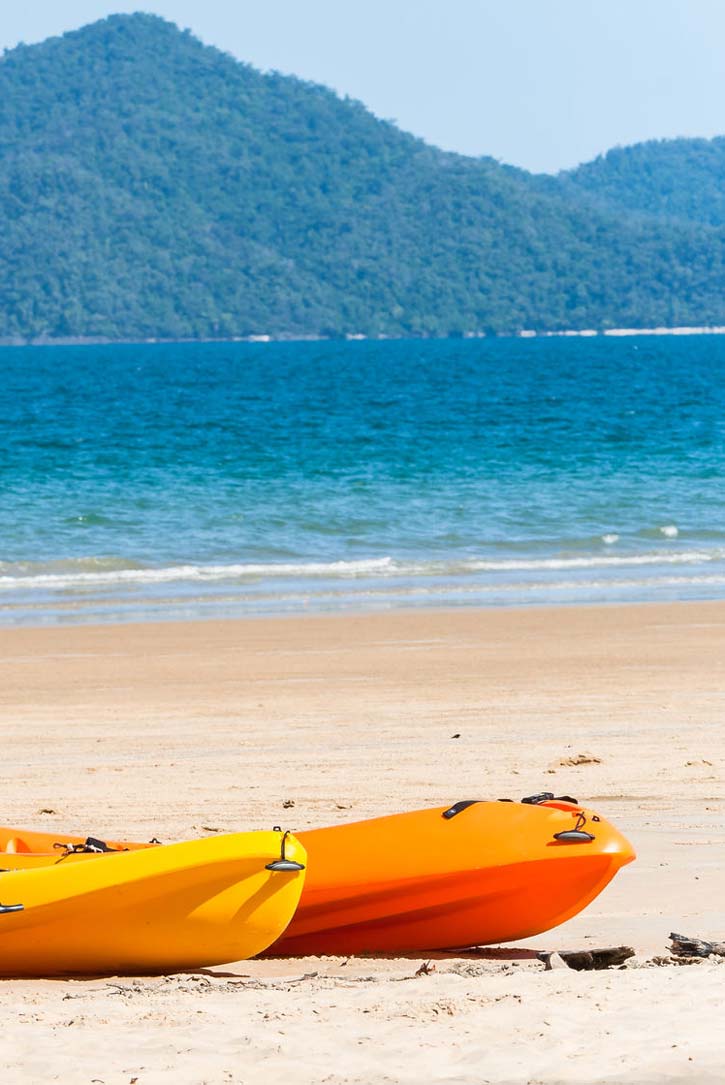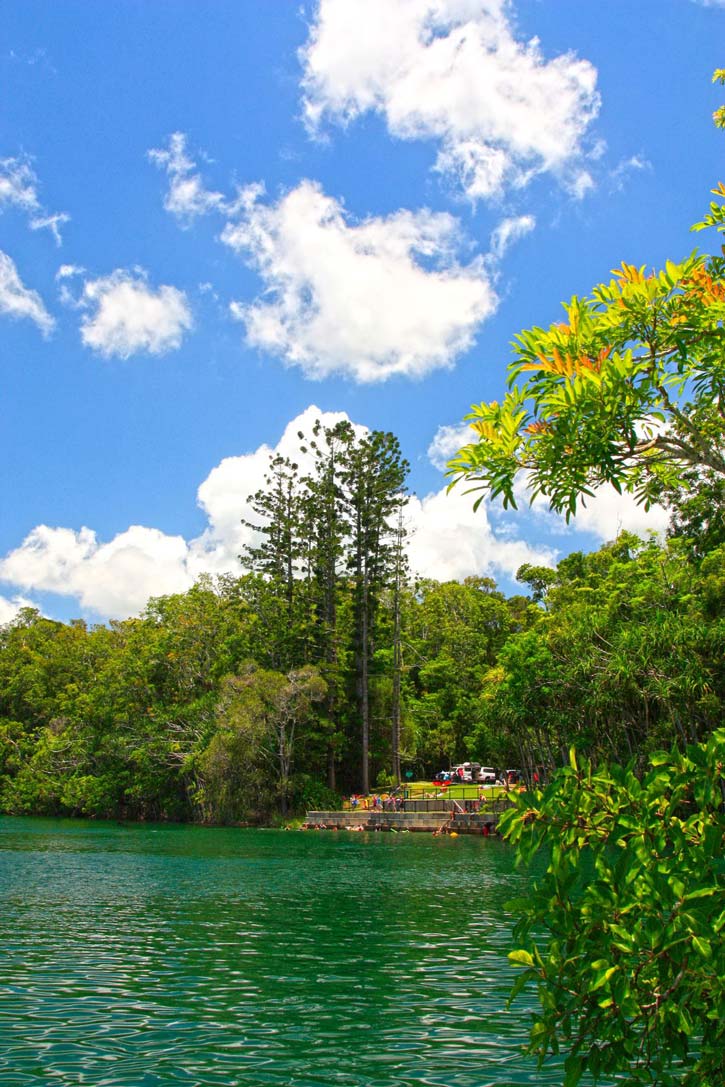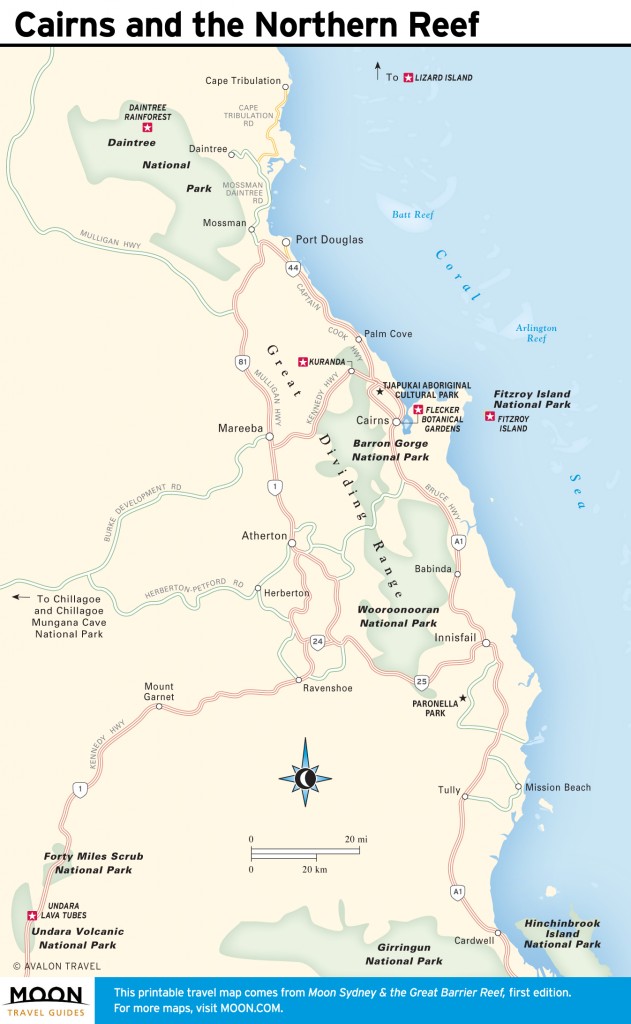Fitzroy Island is a little closer to Cairns and is more sedate, with a quiet resort, a house reef, some kayaking, and a couple of beautiful beaches. Green Island, on the other hand, is a full-on tourist attraction, which can turn into a bit of a circus, but if you have kids to entertain and a saunter along the beach or hike through the forest with a sedate lunch just won’t cut it, this is your option. There’s snorkeling, diving, swimming, glass-bottom boat touring, an observatory, a small weird museum, nature walks, a bar, barbecues, pontoons, and more to keep everybody happy and make for a fun- and people-filled day.

Cairns’ Mission Beach offers amenities on top of beautiful sand and surf. Photo © Chris Van Lennep/123rf.
However, it would be best to dedicate a little more time to this part of the world. A minimum of three days, maybe a week would be good, and more would be better.
Once you have the base, choose your trips. This region is not explored on foot, although hikes and boardwalks take a high priority when it comes to closely experiencing it. You will need to choose a base and take day trips from there, be it by car or via organized tours. Everybody vaguely connected with tourism in Queensland is aware of this, and the number of tour operators and the combinations they offer is mind-boggling. So, your base should either be Cairns or Port Douglas. Cairns has the airport on the doorstep; Port Douglas is an hour’s drive farther north. Cairns is young, bustling with a clientele of backpackers and lots of local and Asian tourists. Fast food restaurants line the Esplanade, live music thumps out of pubs all evening, and there is always something on. Port Douglas is popular with western tourists, many Europeans and Americans. There are no traffic lights and no fast food outlets, although you can get a burger or taco in town; rather, the emphasis is on fine—if relaxed—dining, and it’s a quieter stay all around. Both places offer access to all the day trips, but Port Douglas is an hour closer to the Daintree.Once you have the base, choose your trips. Obviously you will need to spend at least one day on the reef and then one day in the forest, so a day trip to Cape Trib, as it is affectionately called, maybe combined with some croc spotting and a guided nature walk, is in order. If you can spend a night at the Undara Experience, then you could leave your base in the morning, take a leisurely drive through the Atherton Tablelands, get to Undara in the late afternoon in time for sunset. Spend the night, explore the tubes, and head back to base taking a different route through the tablelands.

Lake Eacham in the Atherton Tablelands. Photo © ekays/123rf.
Depending on what you want and need out of this trip, and whom you are traveling with, the region offers a plethora of thrill-seeking activities, be it bungee jumping, ziplining, or wild-water rafting, as well as more serene ways of spending the day, such as taking the cable car to Kuranda, doing some shopping in the market, and taking the scenic railway back.
Always bear in mind that this is the tropical north of Australia, and a rainforest doesn’t get its name without some precipitation around. The temperatures are never really cold, with summer (Nov.-Feb.) temperatures between 24 and 33 degrees Celsius (75 to 91 degrees Fahrenheit), and in winter (July-Sept.) between 14 to 26 degrees Celsius (57 to 79 degrees Fahrenheit). The summer is the wet season, the so-called “green season,” stretching from the onset of the monsoon (usually in November) and ending in May. The rain makes it hot and humid, at times uncomfortable, and can hamper the excursions, although places such as the Undara Lava Tubes adapt to the seasons and, if the tubes are filled with water, offer snorkeling excursions instead of the boardwalk.

Cairns and the Northern Reef
The dry season; i.e., the southern hemisphere winter, is the high season up here, drawing more visitors and inviting higher prices. Australian schools have generally a two-week vacation in early July and another in September, and there are some Europeans around on long excursions throughout the season. If you can plan for August, or the fringe times, you should not be overrun with people and should be able to enjoy some of the 300 days a year of sunshine without being too hot.
The water is warm enough to swim in all year round, but keep in mind that box jellyfish populate the shallow waters from October to May. These are nasty critters, giving bad stings, but most popular beaches offer “stinger nets”—netted areas on the beaches to swim in safely. Do check about the conditions before you head to the beaches.
Excerpted from the First Edition of Moon Sydney & the Great Barrier Reef.